Farmers can get a €2,000 voucher from the Sustainable Energy Authority of Ireland (SEAI) for an energy audit on their farms. This audit identifies their energy usage, equipment/processes consuming the most energy, suggests ways to save energy and estimates their associated costs/impacts.
The application process is simple but farmers must have spent over €10,000 on energy (electricity, gas, diesel, etc) on their farm in the previous year to be eligible.
To learn more about the audit process, the Irish Farmers Journal joined Kevin Carey from Atlantic Energy Consulting as he conducted an SEAI energy audit with dairy farmer Thomas Francis in Ballyvaughan, Co Clare.
Atlantic Energy Consulting, run by Kevin, offers a “one-stop-shop” service to farmers across the country.
He and his team can complete the energy audit, collaborate with advisers to complete TAMS, SEAI or any other Government schemes applications on the farmer’s behalf, and manage energy upgrades and solar PV installations.
Dairy farm
Thomas Francis farms with his father, Tony, in Ballyvaughan, Co Clare.
Thomas is in his second year of full-time farming and manages the farm. Sustainability is a top priority for him and, by 2025, he aims to have all energy consumed on the farm from renewable sources.
He milks 92 Friesian cows using an eight-unit double-up herringbone parlour.
Although the farm is already modern and efficient, there are still some areas that require improvement.

The conventional eight-unit double-up herringbone parlour.
Thomas applied for the €2,000 voucher from the SEAI and appointed Kevin as the auditor. Once he received his confirmation email and number, he arranged a date and time for the audit.
Farm walkthrough
At Thomas’s farm, Kevin and I started by requesting copies of energy-related bills from the past year. This helped us determine the farm’s energy demand, cost, and estimated energy-related CO2 emissions.

The slurry agitator uses compressed air to constantly agitate.
The farm primarily uses imported electricity, LPG and diesel. We then conducted a walkthrough using the SEAI audit template, inspecting all energy-consuming equipment on the farm.

The bulk tank is relatively modern.
Solar PV: Thomas currently does not have a solar PV system installed so this will be a recommendation. During the farm walkthrough, Kevin quickly identified the ideal location for the panels – a south-facing roof on a new cattle shed. He noted that a steel cage would need to be installed under the windows on the roof to qualify for TAMS III funding.

The south-facing roof on a new cattle shed is a good location for solar panels.
Water heating: Thomas runs a modern LPG hot water boiler with digital thermostat controls. While it is efficient, it is expensive to operate. There may be an opportunity to take advantage of grant aid to install a heat pump and transition away from gas.
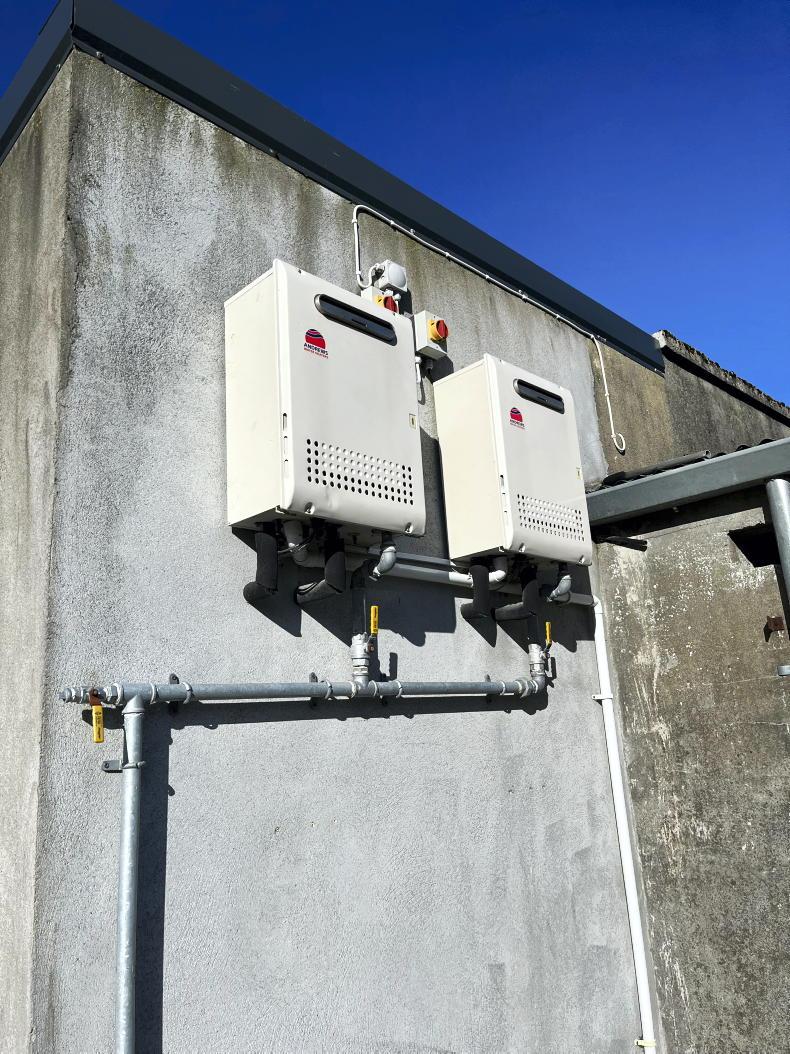
He uses gas to heat water.
Milk cooling: the 10,000l bulk tank uses electricity to chill milk. Although the tank is relatively modern and efficient, it could be powered using renewable electricity.
Hot water pipes: certain hot water pipes around the parlour lack insulation, resulting in heat loss. Insulating these pipes is a simple fix.

Heat is lost through uninsulated pipes.
Monitoring system: Thomas currently doesn’t have an energy monitoring system is place. By investing in one, he can gain a better understanding of where and how energy is consumed around the farm.
Pumps: Thomas has already installed a modern variable-speed milk pump, which is a highly efficient system. Kevin believes that there would be no need for it to be replaced.

Thomas installed a modern variable speed milk pump.
Lighting: all of the lights around the farmyard have already been replaced with efficient LED lights and yard sensors have been installed outside. Therefore, Kevin does not believe that anything will need to be upgraded here.
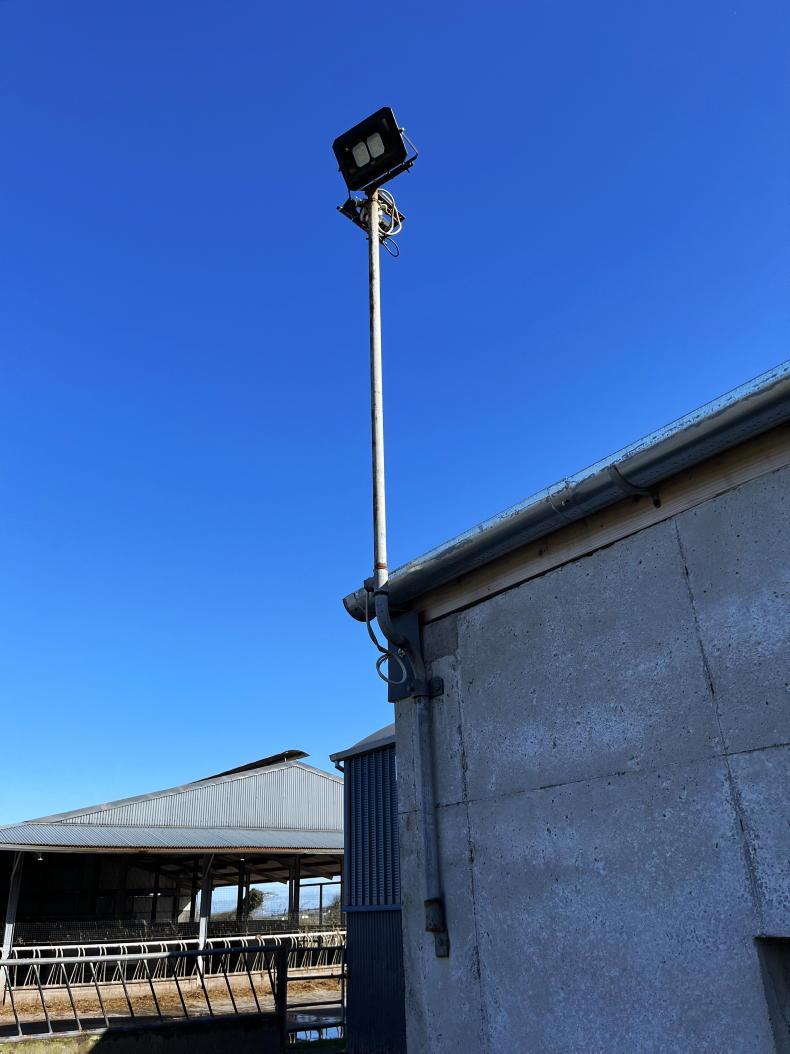
All of the lights have already been replaced with efficient LED lights.
Heat recovery: there are currently no heat recovery systems on the farm to capture and reuse excess and waste heat. Kevin anticipates that this will likely be a recommendation for Thomas.
Water: rainwater could be harvested from shed roofs and used to supply drinking troughs and some of the water supply in the yard. Rainwater harvesting equipment is eligible under for grant aid under TAMS.
Vehicles: the farm runs two Massey Ferguson tractors and a Land Cruiser jeep. Although renewable alternatives such as biogas-fuelled tractors are available in the market, it is not currently practical to switch to them.
Slurry agitator: the farm features a distinctive system that uses compressed air to constantly agitate slurry. This negates the need to agitate before spreading. The system is relatively efficient, and Kevin does not anticipate any recommendations in this area.
Grid connection: the farm will have to notify the ESB that they will be installing solar PV panels and will likely export an amount of energy. As Thomas’s farm in on a three-phase connection and his solar PV panels are likely to be larger than 11kW, he will have to apply for an NC7 network connection.
Household: the farm household is on a separate electricity meter, so it cannot be included in the farm’s energy demands when determining the appropriate panel size needed for TAMS.
After the farm visit, Kevin compiled a list of recommended steps for Thomas to improve the energy efficiency of his farm and reduce energy expenses.
Table 1 outlines a number of typical recommendations for an average dairy farm. However, given the current economic conditions the estimated costs are only intended as a reference.

A steel cage would need to be installed under the windows on the roof.
Many of the actions which would be included in this list have already been implemented on Thomas’s farm.

Kevin looked at renewable options for Thomas's tractor.
Farmers can get a €2,000 voucher from the Sustainable Energy Authority of Ireland (SEAI) for an energy audit on their farms. This audit identifies their energy usage, equipment/processes consuming the most energy, suggests ways to save energy and estimates their associated costs/impacts.
The application process is simple but farmers must have spent over €10,000 on energy (electricity, gas, diesel, etc) on their farm in the previous year to be eligible.
To learn more about the audit process, the Irish Farmers Journal joined Kevin Carey from Atlantic Energy Consulting as he conducted an SEAI energy audit with dairy farmer Thomas Francis in Ballyvaughan, Co Clare.
Atlantic Energy Consulting, run by Kevin, offers a “one-stop-shop” service to farmers across the country.
He and his team can complete the energy audit, collaborate with advisers to complete TAMS, SEAI or any other Government schemes applications on the farmer’s behalf, and manage energy upgrades and solar PV installations.
Dairy farm
Thomas Francis farms with his father, Tony, in Ballyvaughan, Co Clare.
Thomas is in his second year of full-time farming and manages the farm. Sustainability is a top priority for him and, by 2025, he aims to have all energy consumed on the farm from renewable sources.
He milks 92 Friesian cows using an eight-unit double-up herringbone parlour.
Although the farm is already modern and efficient, there are still some areas that require improvement.

The conventional eight-unit double-up herringbone parlour.
Thomas applied for the €2,000 voucher from the SEAI and appointed Kevin as the auditor. Once he received his confirmation email and number, he arranged a date and time for the audit.
Farm walkthrough
At Thomas’s farm, Kevin and I started by requesting copies of energy-related bills from the past year. This helped us determine the farm’s energy demand, cost, and estimated energy-related CO2 emissions.

The slurry agitator uses compressed air to constantly agitate.
The farm primarily uses imported electricity, LPG and diesel. We then conducted a walkthrough using the SEAI audit template, inspecting all energy-consuming equipment on the farm.

The bulk tank is relatively modern.
Solar PV: Thomas currently does not have a solar PV system installed so this will be a recommendation. During the farm walkthrough, Kevin quickly identified the ideal location for the panels – a south-facing roof on a new cattle shed. He noted that a steel cage would need to be installed under the windows on the roof to qualify for TAMS III funding.

The south-facing roof on a new cattle shed is a good location for solar panels.
Water heating: Thomas runs a modern LPG hot water boiler with digital thermostat controls. While it is efficient, it is expensive to operate. There may be an opportunity to take advantage of grant aid to install a heat pump and transition away from gas.

He uses gas to heat water.
Milk cooling: the 10,000l bulk tank uses electricity to chill milk. Although the tank is relatively modern and efficient, it could be powered using renewable electricity.
Hot water pipes: certain hot water pipes around the parlour lack insulation, resulting in heat loss. Insulating these pipes is a simple fix.

Heat is lost through uninsulated pipes.
Monitoring system: Thomas currently doesn’t have an energy monitoring system is place. By investing in one, he can gain a better understanding of where and how energy is consumed around the farm.
Pumps: Thomas has already installed a modern variable-speed milk pump, which is a highly efficient system. Kevin believes that there would be no need for it to be replaced.

Thomas installed a modern variable speed milk pump.
Lighting: all of the lights around the farmyard have already been replaced with efficient LED lights and yard sensors have been installed outside. Therefore, Kevin does not believe that anything will need to be upgraded here.

All of the lights have already been replaced with efficient LED lights.
Heat recovery: there are currently no heat recovery systems on the farm to capture and reuse excess and waste heat. Kevin anticipates that this will likely be a recommendation for Thomas.
Water: rainwater could be harvested from shed roofs and used to supply drinking troughs and some of the water supply in the yard. Rainwater harvesting equipment is eligible under for grant aid under TAMS.
Vehicles: the farm runs two Massey Ferguson tractors and a Land Cruiser jeep. Although renewable alternatives such as biogas-fuelled tractors are available in the market, it is not currently practical to switch to them.
Slurry agitator: the farm features a distinctive system that uses compressed air to constantly agitate slurry. This negates the need to agitate before spreading. The system is relatively efficient, and Kevin does not anticipate any recommendations in this area.
Grid connection: the farm will have to notify the ESB that they will be installing solar PV panels and will likely export an amount of energy. As Thomas’s farm in on a three-phase connection and his solar PV panels are likely to be larger than 11kW, he will have to apply for an NC7 network connection.
Household: the farm household is on a separate electricity meter, so it cannot be included in the farm’s energy demands when determining the appropriate panel size needed for TAMS.
After the farm visit, Kevin compiled a list of recommended steps for Thomas to improve the energy efficiency of his farm and reduce energy expenses.
Table 1 outlines a number of typical recommendations for an average dairy farm. However, given the current economic conditions the estimated costs are only intended as a reference.

A steel cage would need to be installed under the windows on the roof.
Many of the actions which would be included in this list have already been implemented on Thomas’s farm.

Kevin looked at renewable options for Thomas's tractor.















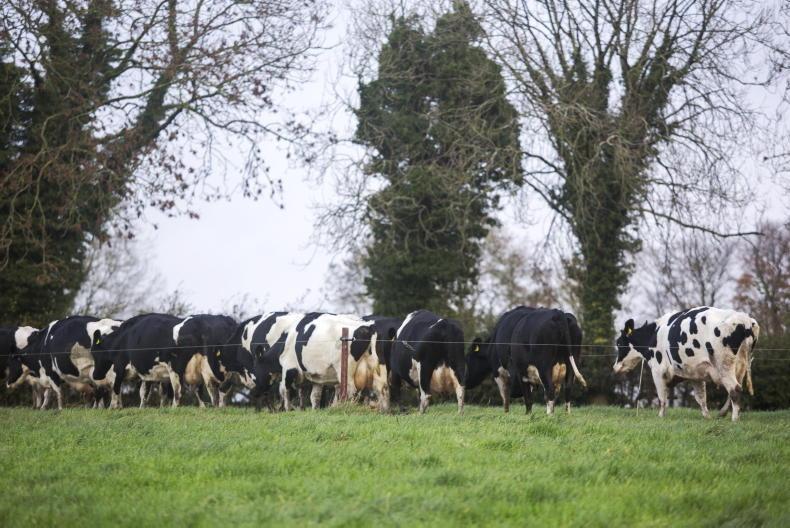

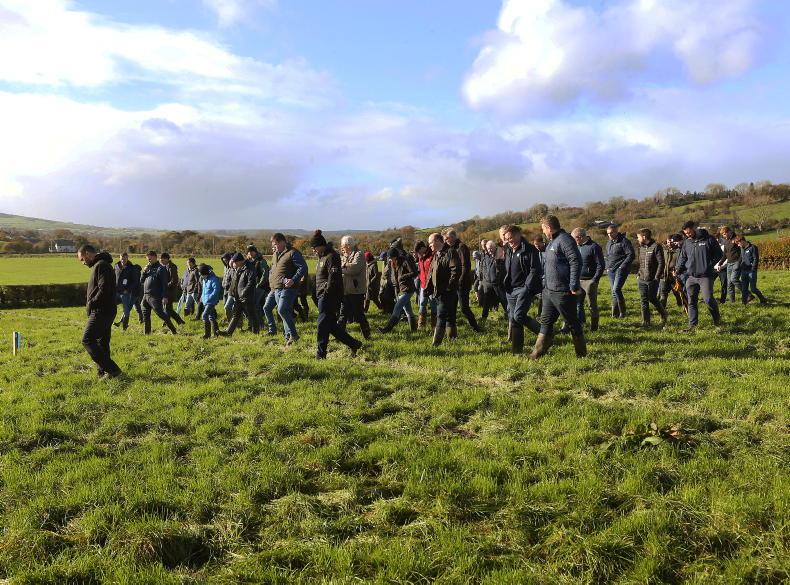
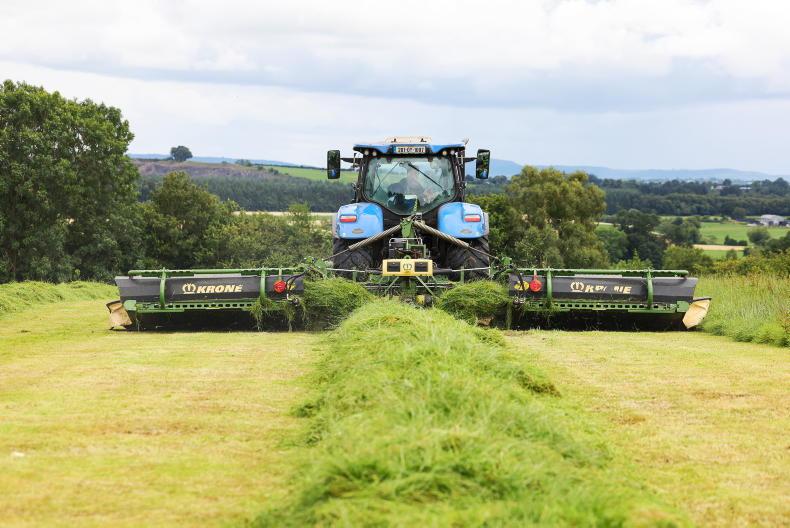
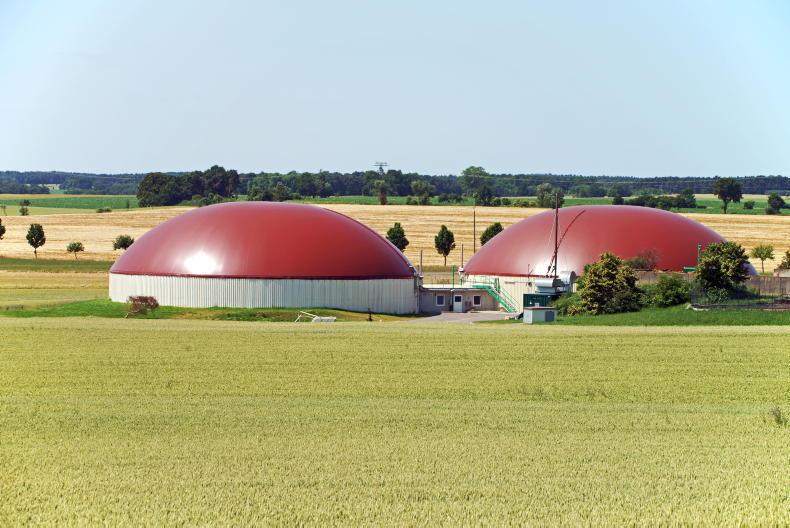
SHARING OPTIONS